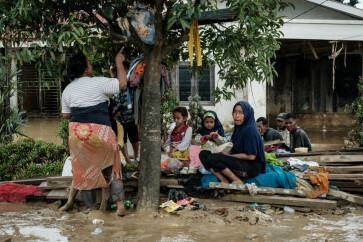Popular Reads
Top Results
Can't find what you're looking for?
View all search resultsPopular Reads
Top Results
Can't find what you're looking for?
View all search resultsThe day Indonesia goes dark at dawn
After 21 years, Indonesians have the chance to witness a total solar eclipse
Change text size
Gift Premium Articles
to Anyone
After 21 years, Indonesians have the chance to witness a total solar eclipse.
On March 9, one of the most extraordinary astronomical phenomena ' a total solar eclipse ' will appear in Indonesia's sky.
In the morning, the Earth, moon and sun will perfectly align, producing a total solar eclipse across the archipelago after 21 years.
An eclipse occurs quite often, but what makes it special is that it takes different path on every cycle.
'The total eclipse will appear in Indonesia in March, but next year, it will be visible in the US,' said Clara Yono Yatini, head of the National Total Eclipse Committee 2016, who is also a researcher at the National Institute of Aeronautics and Space (LAPAN).
Indonesia experienced a total solar eclipse in 1988, which was visible from Bangka Belitung and South Sumatra. In 1995, the country observed another total eclipse, but it was only visible from Sangihe, a small island in North Sulawesi.
On March 9, the darkest part of the moon's shadow ' called umbra ' will touch down at sunrise over Sumatra and travel eastward toward Hawaii. Anyone situated somewhere along this narrow path will experience a total eclipse.
Residents of Sumatra will be the first to see the moon cover the entire surface of the sun, presenting an eerie twilight and revealing the ghostly corona ' the outer atmosphere of the sun.
In Palembang, South Sumatera, the partial eclipse will be visible at 6:20 a.m (10 minutes after sunrise) and will form a total eclipse at 7:20 a.m., according to data compiled by LAPAN. The total eclipse will last 1 minute and 51 seconds.
The path of totality stretches across 11 provinces. Within two hours, the umbra will move toward Bangka Belitung, Central Kalimantan, Central Sulawesi and northern part of Maluku.
Residents of Luwuk in Central Sulawesi will experience the longest total eclipse, lasting two minutes and 50 seconds.
In Halmahera of Maluku, the total eclipse will be visible at 9:54 a.m. for one minute and 36 seconds before heading out into the Pacific.
Outside the narrow path of totality, the eclipse will be partial. Observers in Medan of North Sumatra, Java and Bali and Papua will see a crescent-shaped sun as the Moon passes by off-center.
In Jakarta, the crescent will be visible from 6:19 a.m. until 8:31 a.m.
'These places will experience varied degrees of partial eclipse. For example, those in Jakarta will see an almost 90 percent eclipse, while those in Surakarta (Central Java) will only see 80 percent,' Clara said.
Spectators must not look at a partial eclipse with the naked eye. The extremely bright part of the crescent can cause permanent damage to the eye.
'The observers can wear sunglasses with an ND5 solar filter, which reduces the light intensity by 100,000 times. You can take them off during the total eclipse, but don't forget to put them on again when the partial eclipse reappears,' Clara recommended.
Viewers can also see the eclipse's projection using two pieces of card. Make a hole in one card and use it to project an upside-down image of the sun onto the other. A simpler way to avoid looking straight at the sun is to watch the reflection of the eclipse on water.
Live streaming of the total eclipse can be accessed at www.gerhana-indonesia.id and http://media.bmkg.go.id/.
Researchers from LAPAN and NASA will conduct a joint observation in Maba, Halmahera in North Maluku.
'During the total crescent, we get a chance to observe the shapes of the sun's corona,' Clara said.










